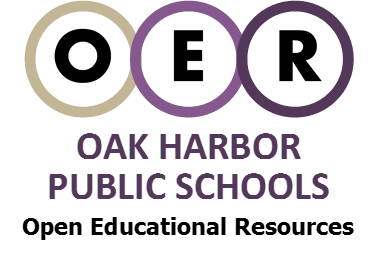Conceptu

Oak Harbor Public Schools Open Educational Resources
Conceptual Chemistry is a year-long course by Oak Harbor Public Schools in Washington.
This resource contains links to content produced by other organizations which may use a different license. Please confirm the license status of these third-party resources and understand their terms of use before reusing them
An editable and ADA compliant version of this course will be uploaded soon.
Background
Conceptual Chemistry is a year-long course based on CK-12 OER instructional material and supplemented with limited commercially-available materials. The course is project-based, argument-driven inquiry. Each quarter begins with presentation of an intriguing phenomenon, followed by an essential question about the phenomenon, and a project centered on answering that essential question. Throughout the quarter, students conduct research and investigations to answer portions of the question. Each unit has a student "Task" at the end that serves as an assessment of the unit's concepts. At the end of each quarter, students assemble all of the unit tasks and synthesize a personal final project that answers the essential question in a personal context chosen by the student.
The new chemistry course is exactly as its name implies: conceptual. The content of a traditional college prep chemistry course is largely analytical, focusing heavily on performing mathematical computations to solve problems involving quantities of substances and their properties. The conceptual chemistry course focuses more on developing a literacy in the underlying big ideas of the structure and function of matter and how those structures and function relate to the Earth, the environment and students' daily lives. Rather than practicing intensive computational skills, time is spent developing a robust understanding of the role that chemistry plays in critical topics such as the origin of elements, consumption of energy and natural resources, climate change, and the interaction of matter and energy.
Each quarter, students complete a final project as the summative assessment for the quarter. This is in contrast to the traditional final exam approach to measuring student understanding. At the beginning of the quarter, students choose a specific topic that is of interest to them personally. Through the quarter, students develop their final projects via a series of end-of-unit "Tasks" that have students summarize their learning and reflect on how each concept applies to their chosen topic. At the end of the quarter, students assemble of the information and reflections from their Tasks to synthesize their final projects. The nature and format of these projects differs each quarter as the content matter dictates.
For example, at the beginning of Quarter 1, students chose an element from the periodic table. As students work their way through the quarter, they learn about atomic structure, patterns on the periodic table and how those things determine and predict the properties and behavior of elements and how the elements are formed inside of stars. Throughout the quarter, students complete a set of tasks on Google Slides that have them explain how each concept applies to their chosen elements. For the final project, students transfer all of the information from their Slides into a presentation format of their choice: scrapbook, handbook, bulletin board, newspaper advertisement, digital infographic, or another choice approved by the teacher. Students present these projects to the wider school audience in the form of a science gallery.